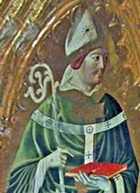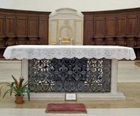


St John of Spoleto
Detail of Sant’ Eufemia Triptych (1450)
Museo Diocesano
St John of Spoleto (19th September)
This was almost certainly Bishop John of Spoleto, who was documented in ca. 500. A legend (BHL 4437-8) in the Leggendari del Duomo (see below) records that Bishop John was killed by Goths, and this is usually assumed to have happened in 546, when the city (which had been in Byzantine hands for the previous decade) surrendered to Totila. (Another version of the legend has St John killed by Saracens in 887).


“Sancti Iohannis archiepiscopus” (St John, archbishop) was among the patron saints of Spoleto whose feasts were mentioned in the city statutes of 1296.
Legend of St John of Spoleto
Unusually, the author of the legend is known: he identifies himself as “Giovanni, monaco e peccatore” (John, monk and sinner) from the “sacro cenobio cassinese” (Abbey of Montecassino). He also says that Berta, the abbess of Sant’ Eufemia (presumably Gunderada’s successor) commissioned the legend in the reign of the Emperor Otto II (967-83). This commission probably occurred soon after the translation of the relics, and would have marked the initiation of the cult.
The legend contains some important information about Spoleto in the 10th century:
-
✴A number of bishops of had been buried in “ aula del beato Pietro Apostolo” (San Pietro). These included Bishop Petrus (Peter), whose epitaph in verse survived.
-
✴His reference to the “episcopatum Genitricis Domini nostri” (the Mother of Our Lord) represents one of the earliest surviving reference to the Duomo.
-
✴The body of Bishop Spes remained in a sarcophagus at SS Apostoli.
-
✴The “cenobio del beatissimo Ponziano” (San Ponziano) stood on the site of a cemetery that housed the relics of martyrs.
-
✴The city had an abundance of water, which was delivered from two directions by aqueducts.
-
✴The city was enjoying a period of renewal after Saracens had destroyed it.
St John Penariensis (19th March)
The Roman Martyrology records, under March 19th:
-
“In the city of Pinna, the birthday of blessed John, a man of great sanctity, who came from Syria into Italy, and there founded a monastery. After being the spiritual guide for many of God's servants for forty-four years, he rested in peace”.
St John Penariensis, a holy man from Syria, first appears under 19th March in the Martyrology of Adon (858). An entry in the Martyrology of Florus (825-40) under the same date for St John the hermit (from an unspecified location) probably refers to St John of Penariensis.
The legend of St John Penariensis (BHL 4420) appears in the Leggendari del Duomo. This records that he came from Syria and lived as a hermit outside Spoleto. The local people were extremely suspicious of him until they saw him sitting under a tree that was in full bloom, despite the fact that it was winter. They immediately called Bishop John of Spoleto (see above) to witness the miracle. The bishop gave John permission to establish a monastery on the site, and he lived there for 44 years. The church of San Giovanni di Panaria (12th century), between Perchia and Baiano (some 10 km south west of Spoleto) is usually said to stand on this site.
There are a number of parallels between the legend of this saint and that of St Isaac:
-
✴both were men of God who came to Spoleto from Syria, probably in the 6th century;
-
✴both were initially viewed with suspicion; and
-
✴both established eremetical monasteries outside the city.
St John and Syria
Legend of the Twelve Syrians
St John appears in all the Legend of the Twelve Syrians. This recounts how he travelled from Syria to Rome with his extended family in the reign of the Emperor Julian the Apostate (361-3). The family were imprisoned by the Emperor Julian, and St Anastasius, the pater familias, was executed. The rest of the family left Rome, and subsequently split up. St John travelled to Spoleto with St Brictius, who ordained him as bishop of that city. St John then built the church of San Pietro there.
In fact, Bishop Achilleus built San Pietro in the early 5th century. The legend of St Herculanus (another of the twelve Syrians) says that Bishop John of Spoleto decorated the church and built a staircase there, and this seems be more likely. This bishop became the basis of the cult of St John of Spoleto (see above).
It seems likely that the St John in the Legend of the Twelve Syrians was a composite of the Syrian St John Penariensis and the bishop St John of Spoleto.
Legend of the 300 Syrians
St John Penariensis is named in the legend of St Laurence (BHL 4748 d), who was one of an “infinita turba” (boundless multitude) of Syrian immigrants. By this route he found his way into the Legend of the 300 Syrians, a construct by local scholars in the late 16th and early 17th centuries in which a large group of Syrian monks arrived in Umbria in 516.
The account given by the monk John includes information on the following monuments during the reign of the Emperor Otto II:
San Pietro; the Duomo; SS Apostoli; and San Ponziano.
Return to Saints and Venerated Objects of Spoleto.

